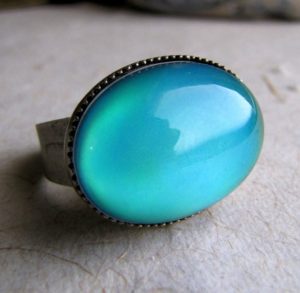Mood Ring Color Meanings
A mood ring is just another jewelry piece but what makes it stand out is that it changes colors, supposedly, according to your mood and that, obviously, is how it got its name.
Invented and patented in the 70s by Josh Reynolds and Maris Ambats, mood rings saw its popularity rise as more and more variations were added in terms of the colors and eventually, to the mood ring color meanings. When you purchase a mood ring, you can expect it to be in green or blue as it is its default color, signifying that the mood ring is at rest. The moment you put it on, the mood ring will start to transform into any of these colors:
• Violet – In Love, Happy, Aroused
• Blue – Calm, Peaceful
• Green- Neutral
• Yellow – Nervous, Unsettled, Edgy
• Brown – Tensed, Anxious
• Black – Very cold temperature, or this could also indicate a damage in the ring
As more and more companies are making mood rings, more shades are added on the list, making the mood ring color meaning varies according to their manufacturers. However, the universal rule is that black is the highest shade the ring can go when it’s cold, while violet is on the opposite side of the spectrum.
How Do Mood Rings Work?
So, how can a mood ring tell your mood? The answer lies beneath the ring – literally. A mood ring is made up of a liquid crystal enclosed in a transparent concave glass. The liquid crystal has the ability to change color in response to its surrounding temperature, a property that is called thermochromism.
Using the above guidelines, the mood ring will turn black in cold temperature and will climb up to the shade of violet as the temperature gets warmer. When worn, the mood ring will now respond to the wearer’s temperature.
This is where the science behind the mood ring color meanings come in. When we are happy or are feeling romantic, our brain signals the nervous system to release the adrenaline hormone. The adrenaline is the one responsible in making the blood flow increase in our body, making us blush, and thus, making our body feeling warmer. The mood rings pick up this temperature and change into violet or in similar shades.
On the other hand, do you remember the time when you were anxious your hands and feet were icy cold? Anxiety does that to our body. When you are restless, nervous, or scared, the vessels pump the blood away from the extremities and into our internal organs as the body’s defense mechanism. Cold hands and feet are often associated with these feelings and because the mood ring is temperature-sensitive, it will change its color because of the coldness.
How Accurate Is The Mood Ring?
Originally described in its patent as nothing more than a temperature-sensitive novelty item, Reynolds and Ambats marketed it as rings that can provide a visual representation to your emotional state.
As hard to believe that a piece of ring can tell how you feel, there is actually a grain of truth to it. The mood ring’s accuracy, however, is disputable. For instance, a mood ring will change into a warm color (a.k.a. the happy color) even when in reality, you just walked out of the gym. The real deal breaker, however, is that the mood ring is actually more influenced by the external temperature around it and less on the temperature around your fingers.
In spite of the fact that mood rings cannot really definitively represent your current feelings, people are still drawn into them because of their novelty. It is an interesting addition to any outfit and can also double as a conversation starter not to mention becoming a bold fashion statement.
It may not turn you into the next Kate Moss but if nothing else, mood rings just look so damn good.
